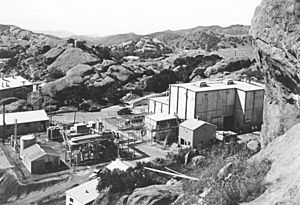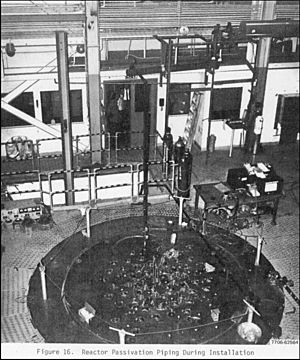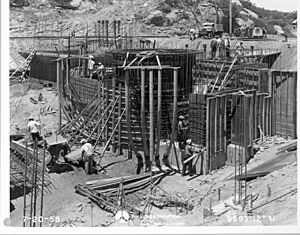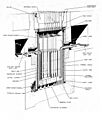Sodium Reactor Experiment facts for kids
Quick facts for kids Sodium Reactor Experiment |
|
|---|---|

The Sodium Reactor Experiment facility in 1958
|
|
| Country | United States |
| Location | Santa Susana Field Laboratory, California |
| Coordinates | 34°14′7″N 118°42′30″W / 34.23528°N 118.70833°W |
| Status | Decommissioned |
| Construction began | 1954–1957 |
| Commission date | July 12, 1957 |
| Decommission date | February 15, 1964 |
| Owner(s) | Atomics International Division, North American Aviation |
The Sodium Reactor Experiment (SRE) was an important early nuclear power plant. It was built by a company called Atomics International. The SRE was located at the Santa Susana Field Laboratory near Simi Valley, California. This reactor operated from 1957 to 1964.
On July 12, 1957, the SRE became the first nuclear reactor in California to make electricity. This power was sent to the regular power grid, lighting up the nearby city of Moorpark. In July 1959, the reactor had a problem. Some of its fuel parts got too hot and partly melted. A small amount of radioactive gas was also released into the air. The reactor was fixed and started working again in September 1960. The SRE was shut down for good in February 1964. Its removal was finished in 1981.
Contents
What Was the Sodium Reactor Experiment?
The Sodium Reactor Experiment was a special kind of nuclear reactor. It was designed to test new ways of making electricity from nuclear power. The main goal was to see if a reactor cooled by liquid sodium could work well. This was a big step in developing safer and more efficient nuclear power.
Where Was the SRE Located?
The SRE facility was in a part of the Santa Susana Field Laboratory. This area is known as Area IV. It sits on a mountaintop called The Hill. The location is about 30 miles (48 km) northwest of downtown Los Angeles.
When the SRE was running, the Santa Susana Field Laboratory had two main parts. The Rocketdyne division tested liquid-propellant rocket engines there. The Atomics International division worked on nuclear reactors. They developed reactors for commercial use and for outer space missions.
Building and Operating the SRE
In 1954, the United States Atomic Energy Commission decided to build five experimental reactors. These reactors would test different designs. The SRE, designed by Atomics International, was one of them. Its design started in June 1954, and construction began in April 1955.
A local power company, Southern California Edison, helped. They set up and ran the system that turned the reactor's heat into 6.5 megawatts of electricity. The reactor first started making controlled nuclear fission on April 25, 1957.
The Los Angeles Times newspaper wrote a big story when Moorpark got its power from the SRE. A famous TV show, See It Now, also featured the event. This happened on November 24, 1957.
How the SRE Worked
The SRE used sodium as a coolant. This means liquid sodium carried away the heat made by the reactor. This hot liquid sodium flowed through pipes. Pumps moved the sodium around the system. These pumps had special seals to stop the hot sodium from leaking. A fluid called tetralin was used to cool these pump seals.
The reactor core was inside a stainless steel container. This container was filled with liquid sodium. The SRE reactor core had 43 fuel elements. Each fuel element contained seven fuel rods. A fuel rod was a stainless steel tube about six feet long. It was filled with twelve uranium fuel slugs.
At full power, sodium entered the reactor at about 500°F (260°C). It flowed through the core, picking up heat from the fuel. The sodium then left the core at about 950°F (510°C). This hot sodium then went to heat exchangers. These exchangers used the heat to boil water, making steam. The steam then powered a turbine to generate electricity.
The 1959 Incident
In July 1959, a problem happened at the SRE. The fluid used to cool the pump seals, tetralin, leaked into the main sodium cooling system. The hot sodium broke down the tetralin. This created a sticky residue. This residue then clogged some small cooling channels inside the reactor. These channels were important for the sodium to remove heat from the fuel elements.
Because the cooling channels were blocked, 13 of the reactor's 43 fuel elements got too hot. They were damaged. The exact date this happened is not known, but it was likely between July 12 and July 26.
What Happened During the Incident?
At the time, the reactor operators knew something was unusual. But they did not know the fuel was damaged. They kept the reactor running for a few days. Then they shut it down to check. When they tried to remove the fuel elements, some were stuck. Parts of the damaged fuel elements fell to the bottom of the reactor.
Over the next few months, workers removed all the stuck fuel elements. They also cleaned the sodium system. A new reactor core was put in. The SRE was restarted on September 7, 1960. This was almost 14 months after the incident.
Radioactivity Release
During the incident, radiation monitors were working. After the fuel damage, radioactive materials were released into the reactor's sodium and the gas above the reactor. Researchers found that only radioactive xenon-133 and krypton-85 gases were in the gas above the reactor. These gases were collected in tanks. They were allowed to decay (lose their radioactivity) and then slowly released into the atmosphere. This release was controlled and met government safety rules at the time. About 28 curies of these gases were released.
After the Incident
After the 1959 incident, several changes were made to the SRE. The use of tetralin was stopped. The sodium cooling system was improved. The way fuel elements were cleaned was changed to use steam instead of water. The instruments that monitored the reactor were made better. The design of the fuel elements was also changed.
In September 1960, with the repairs done and a new core, the SRE started running again. Before the incident, it had operated for 10,344 hours. After the repairs, it ran for another 26,716 hours. It generated a total of 37 gigawatt-hours of electricity.
In 1964, more changes were planned for the reactor. These were finished in May 1965. However, the Atomic Energy Agency and Atomics International decided to close the reactor instead of restarting it. The process of taking the facility apart, called nuclear decommissioning, began in 1976. This involved removing the reactor core and contaminated soil. Decommissioning was completed in 1981.
In 1985, the United States Department of Energy checked the site. They said there was "no evidence the facilities pose a radiological threat to either personnel or the environment." In 1999, the remaining buildings were torn down and removed.
Images for kids








